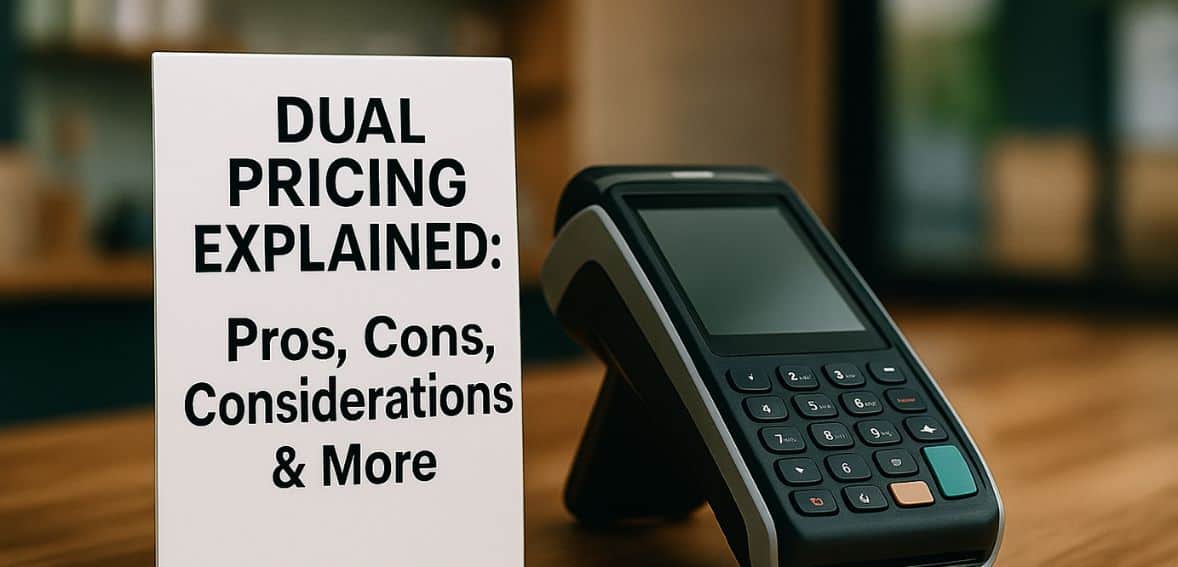
By OliviaMorgan June 9, 2025
Businesses are continuously looking for new methods to maximize revenue, control payment processing expenses, and uphold customer transparency in the rapidly changing retail and service sectors of today. Dual pricing is one tactic that has become more popular recently.
Dual pricing, which displays two prices—one for cash payments and another for card payments—offers an alternative to traditional pricing models and is especially pertinent for small to mid-sized businesses that are struggling with growing interchange fees. This strategy may seem simple at first glance, but it has complex ramifications that call for careful evaluation from the standpoints of operations and customer relations.
Business owners must strike a balance between cost-cutting initiatives and customer satisfaction as customers demand more transparent transactions and seamless payment experiences. By passing the savings on to customers who opt for card payments, dual pricing offers a chance to lower credit card processing costs.
To prevent legal issues, a bad public image, or a drop in customer trust, such a model must be implemented carefully. To assist merchants in making wise choices, this article explores the structure, advantages, disadvantages, compliance concerns, and strategic insights surrounding dual pricing.
Understanding the Mechanics of Dual Pricing

Dual pricing essentially entails showing two different prices for each good or service: one for customers who pay with cash and a marginally higher price for those who use a credit or debit card. The cost of the card processing fees that the merchant would otherwise pay is reflected in this price difference.
For example,A coffee shop might charge $4.00 for a latte to patrons paying with cash and $4.20 to those using cards. In order to help businesses avoid fees, which usually range from 2% to 4% per transaction, the goal is to encourage more customers to pay with cash.
This model differs from surcharging, which applies a fixed fee to the total only when a card is used. Instead, dual pricing gives the customer a clear, up-front option.It requires meticulous pricing strategy and updated point-of-sale systems capable of managing multiple pricing structures without causing confusion at checkout.
Why Dual Pricing Is Becoming More Common
Dual pricing is becoming more and more popular due to a number of factors. First, merchants’ processing costs have gone up as a result of the increase in credit card usage. As more consumers choose the ease of card payments, business owners are having to pay more each month to handle those transactions.
Second, dual pricing is seen by many small businesses with narrow profit margins as a practical way to recover costs without raising prices generally. Some people believe that dual pricing is a more equitable strategy because it spares cash-paying consumers from having to cover cardholders’ processing fees.
Business owners who cater to a budget-conscious clientele will find this appealing. Furthermore, a lot of merchant service providers and payment processors now provide dual pricing programs, it has become more accessible and technically feasible for businesses of all sizes.
Advantages of Dual Pricing

The decrease in payment processing fees is one of the biggest advantages of dual pricing. Businesses can reduce the number of transactions that result in fees by offering incentives for cash payments. This can lead to significant savings over time, particularly for low-ticket, high-volume industries like convenience stores, quick-service restaurants, or independent retail stores.
Transparency is an additional benefit. Dual pricing, when done correctly, explains to consumers exactly what they are paying for and why. Instead of concealing card fees in exorbitant prices, retailers can keep their base prices lower and make the additional cost of using a card obvious. Customers have another option with this model: they can pay with cash if they would rather not incur fees.
Dual pricing is frequently more legally sound than surcharging from a compliance perspective, particularly in states or jurisdictions where adding a surcharge is prohibited or necessitates special disclosures. It is more in line with legal definitions of fair pricing because both prices are shown and the cash price is technically the “discounted” price.
Challenges and Drawbacks of Dual Pricing
Dual pricing has its drawbacks despite its advantages. The perception of customers is one of the primary problems. If the discrepancy isn’t made explicit, many customers might interpret the card price as a penalty or hidden cost. If customers feel misled, this may result in complaints, discontent, or even a decline in repeat business. There is also the issue of operational complexity. Marketing materials must display both prices without overcrowding menus or signage, point-of-sale systems must support dual pricing logic, and staff members must be trained to explain the pricing system. At the register, minor mistakes in labeling or communication can cause confusion.
Another factor to take into account is legal compliance. Dual pricing is usually allowed, but it needs to be done carefully to adhere to state and federal regulations. For example, some states have particular rules about how such pricing is displayed, and merchants are required to clearly disclose both prices prior to the transaction.
Key Considerations Before Implementing Dual Pricing

Business owners should thoroughly examine their transaction data to ascertain the proportion of sales made with cash versus cards prior to implementing a dual pricing model. This aids in estimating possible savings and determining whether the modification will result in a significant financial impact.
Understanding your clientele is also crucial. Dual pricing may backfire by annoying customers who don’t carry cash if your target market is primarily card-using or if your brand presents itself as a high-end or convenience-focused enterprise. The functionality of your point-of-sale system or payment processor is another factor to take into account.
Not every system is set up to manage dual pricing right out of the box. Software upgrades or new hardware might be required to control the pricing logic, keep precise records, and generate reports that distinguish between cash and card transactions.
Strategies for Effective Implementation
Effective communication is essential for the successful implementation of dual pricing. Ensure that menus, shelves, and advertising materials all prominently display the price. Teach your staff how to politely and non-confrontationally explain the policy. By framing the model as a “cash discount” as opposed to a fee for using a card, it helps to highlight the advantage for customers who pay with cash rather than penalize card users.
To determine consumer reaction, start with a pilot program. Watch how consumers respond, monitor payment changes, and evaluate if the shift meets your financial goals. For merchant providers, understanding the right selling strategy is key when offering dual pricing solutions to clients.
Keep abreast of local laws as well. To guarantee complete adherence to all applicable laws and industry standards, collaborate with an experienced payment processor or legal advisor. Clarity and transparency are crucial because some states may forbid certain language or demand disclosures in particular formats.
Industry-Specific Examples of Dual Pricing
Different industries use dual pricing in different ways. For example, gas stations often display two prices. Other sectors like construction also deal with unique challenges in construction payments, requiring tailored processing solutions.
Dual pricing may be seen on digital displays or printed menus in the restaurant industry. Customers are made aware right away that the prices displayed are in cash and that there is a slight percentage increase for card payments.
For high-volume items in particular, retail establishments may utilize register displays or shelf tags to draw attention to both prices. Both options may be listed on invoices in service-oriented businesses, such as salons or auto repair shops, so that clients can select their preferred payment method at the register.
Customer Experience and Brand Impact

When done incorrectly, dual pricing can damage a company’s reputation and brand. Consumers may express their dissatisfaction on social media or online review sites if they believe they are being overcharged for using a card. For companies operating in cutthroat markets where client loyalty is brittle, this can be especially harmful.
Maintaining a customer-first mindset is crucial to reducing these risks. When necessary, give courteous explanations, consistent messaging, and obvious signage. To make the model more enticing, think about providing cash-paying customers with perks or loyalty rewards. In the end, whether dual pricing improves or worsens the customer experience depends on how it is explained and presented.
Technological Support and Vendor Partnerships
Selecting the appropriate technology and vendor support are also critical to the success of a dual pricing strategy. Specialized dual pricing programs with integrated compliance and signage support are now available from a large number of merchant service providers.
These solutions make implementation easier by integrating directly with your point-of-sale systems and guaranteeing that reports, price displays, and receipts adhere to operational and legal requirements. You can track the effectiveness of your dual pricing strategy and make necessary adjustments with the help of some systems that even provide real-time data analytics. You can save time and lower risk by working with a vendor who is familiar with your industry and compliance environment.
Monitoring and Adapting Your Strategy
After your dual pricing model is put into place, it’s critical to keep assessing its effectiveness. Are more consumers using cash to make payments? Do you notice a significant decrease in processing fees? Are reviews from customers typically favorable or unfavorable? Check in with employees frequently to find any operational problems, and think about conducting surveys with customers on a regular basis to find out how they feel.
To keep your strategy current and compliant, stay up to date on changing regulations and industry best practices. Don’t be afraid to change or stop using dual pricing if you discover that it is causing problems or not producing the anticipated savings. Being adaptable and quick to respond is essential to keeping a customer-focused business.
Conclusion
Dual pricing is a strong strategy for companies to control growing payment processing expenses without arbitrarily raising prices everywhere. Customers are empowered to choose how they pay, which is in line with their demand for transparency. But careful execution, effective communication, adherence to regulations, and a thorough comprehension of consumer preferences are all necessary for this model to succeed.
Dual pricing can be revolutionary for certain companies, boosting profits and providing a competitive advantage. Others might find it creates more problems than it fixes, particularly those with clients who are frugal. Merchants can ascertain whether dual pricing is the best course of action for their business by carefully balancing the advantages and disadvantages, utilizing the appropriate resources, and paying close attention to customer feedback.